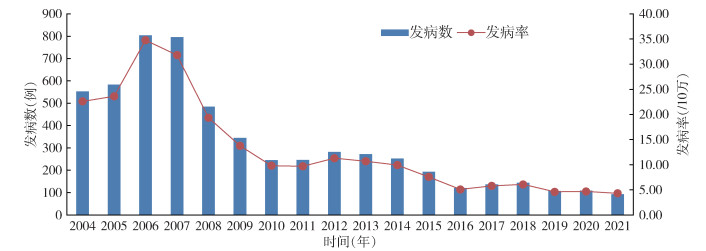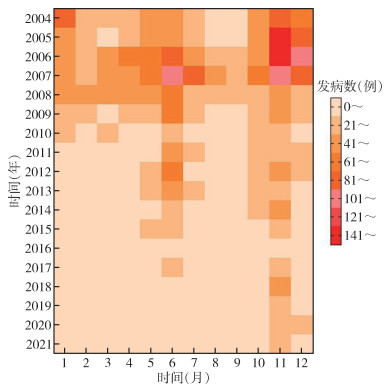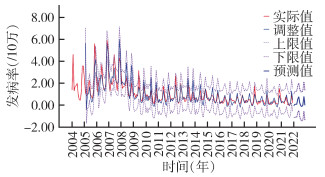| 1 |
Li CP, Cui Z, Li SL, et al. Association between hemorrhagic fever with renal syndrome epidemic and climate factors in Heilongjiang province, China[J]. Am J Trop Med Hyg, 2013, 89 (5):1006-1012.
DOI
|
| 2 |
李兰娟, 任红. 传染病学[M]. 9版. 北京: 人民卫生出版社, 2018: 92- 101.
|
|
Li LJ, Ren H. Infectious diseases[M]. 9th ed. Beijing: People's Medical Publishing House, 2018: 92- 101.
|
| 3 |
路淋. 2005-2020年辽宁省丹东市肾综合征出血热流行特征分析[J]. 预防医学论坛, 2022, 28 (7):552-554.
DOI
|
|
Lu L. Analysis on epidemiological characteristics of hemorrhagic fever with renal syndrome, Dandong city, Liaoning province, 2005-2020[J]. Prev Med Trib, 2022, 28 (7):552-554.
DOI
|
| 4 |
朱珊, 胡益飞. 血常规在成人肾综合征出血热中的应用价值[J]. 中国卫生检验杂志, 2021, 31 (16):2006-2010.
|
|
Zhu S, Hu YF. Application value of complete blood count in adult hemorrhagic fever with renal syndrome[J]. Chin J Health Lab Technol, 2021, 31 (16):2006-2010.
|
| 5 |
陈俊江, 国天赐, 宋姝璇, 等. 中国肾综合征出血热流行特征及时空分析模型进展[J]. 中华流行病学杂志, 2020, 41 (10):1735-1740.
DOI
|
|
Chen JJ, Guo TC, Song SX, et al. Epidemiological characteristics and the development of spatiotemporal analysis models on hemorrhagic fever with renal syndrome in China[J]. Chin J Epidemiol, 2020, 41 (10):1735-1740.
DOI
|
| 6 |
郑兆磊. 山东省肾综合征出血热流行特征与疫源地现状分析[D]. 济南: 山东大学, 2019.
|
|
Zheng ZL. The analysis of current situation of epidemic foci and epidemiological characteristics of hemorrhagic fever with renal syndrome in Shandong province[D]. Ji'nan: Shandong University, 2019. (in Chinese)
|
| 7 |
Lin HL, Zhang ZT, Lu L, et al. Meteorological factors are associated with hemorrhagic fever with renal syndrome in Jiaonan county, China, 2006-2011[J]. Int J Biometeorol, 2014, 58 (6):1031-1037.
DOI
|
| 8 |
吴晓敏, 王艳旭, 包名家, 等. 佳木斯市2004-2017年肾综合征出血热流行病学特征及疫苗效果[J]. 实用预防医学, 2020, 27 (3):300-302.
DOI
|
|
Wu XM, Wang YX, Bao MJ, et al. Epidemiological characteristics of hemorrhagic fever with renal syndrome and effect of vaccination in Jiamusi city, 2004-2017[J]. Pract Prev Med, 2020, 27 (3):300-302.
DOI
|
| 9 |
王敬磊, 赵亚双. 1949-2012年佳木斯市肾综合征流行性出血热流行特征分析[J]. 中华疾病控制杂志, 2015, 19 (2):211-212.
DOI
|
|
Wang JL, Zhao YS. Analysis of the epidemiological characteristics of epidemic hemorrhagic fever with renal syndrome in Jiamusi, 1949-2012[J]. Chin J Dis Control Prev, 2015, 19 (2):211-212.
DOI
|
| 10 |
冯茜, 唐道洲, 李世娥, 等. 2013-2017年哈尔滨市肾综合征出血热流行特征分析[J]. 现代预防医学, 2019, 46 (12):2122-2124, 2178.
|
|
Feng Q, Tang DZ, Li SE, et al. Epidemicological characteristics of hemorrhagic fever with renal syndrome in Harbin from 2013 to 2017[J]. Mod Prev Med, 2019, 46 (12):2122-2124, 2178.
|
| 11 |
王玲, 张艳, 张玲, 等. 2015-2018年淄博市肾综合征出血热流行特征和宿主动物监测[J]. 中华疾病控制杂志, 2020, 24 (2):237-240.
DOI
|
|
Wang L, Zhang Y, Zhang L, et al. Analysis of epidemiological characteristics and surveillance result of host animal on hemorrhagic fever with renal syndrome in Zibo city from 2015 to 2018[J]. Chin J Dis Control Prev, 2020, 24 (2):237-240.
DOI
|
| 12 |
王敬忠, 廖异, 程聪. 深圳市2010-2019年肾综合征出血热流行病学特征[J]. 中国热带医学, 2021, 21 (3):244-246.
DOI
|
|
Wang JZ, Liao Y, Cheng C. Epidemiologic characteristics of hemorrhagic fever with renal syndrome in Shenzhen, 2010-2019[J]. China Trop Med, 2021, 21 (3):244-246.
DOI
|
| 13 |
吴斐琳, 上官致洋, 朱小康, 等. 2011-2016年抚州市肾综合征出血热流行特征分析[J]. 现代预防医学, 2018, 45 (2):204-207, 233.
|
|
Wu FL, Shangguan ZY, Zhu XK, et al. Analysis on the epidemiological characteristics of hemorrhagic fever with renal syndrome in Fuzhou in 2011-2016[J]. Mod Prev Med, 2018, 45 (2):204-207, 233.
|
| 14 |
王芹, 李建东, 张全福, 等. 2014年全国肾综合征出血热监测总结和疫情分析[J]. 疾病监测, 2016, 31 (3):192-199.
DOI
|
|
Wang Q, Li JD, Zhang QF, et al. Surveillance for hemorrhagic fever with renal syndrome in China, 2014[J]. Dis Surveill, 2016, 31 (3):192-199.
DOI
|
| 15 |
王笑辰, 刘文东, 秦圆方, 等. 江苏省2011-2016年肾综合征出血热流行特征及时空聚类分析[J]. 中华疾病控制杂志, 2017, 21 (10):1057-1060, 1065.
DOI
|
|
Wang XC, Liu WD, Qin YF, et al. Epidemiological characteristics and temporal-spatial clustering analysis on hemorrhagic fever with renal syndrome in Jiangsu province, 2011-2016[J]. Chin J Dis Control Prev, 2017, 21 (10):1057-1060, 1065.
DOI
|
| 16 |
华华, 陈淑红, 杨明, 等. 2007-2016年黑龙江省肾综合征出血热疫情分析[J]. 现代预防医学, 2017, 44 (22):4033-4035, 4041.
|
|
Hua H, Chen SH, Yang M, et al. Analysis on the prevalence of hemorrhagic fever with renal syndrome in Heilongjiang province from 2007 to 2016[J]. Mod Prev Med, 2017, 44 (22):4033-4035, 4041.
|
| 17 |
张琼娜, 段春丽, 张绍琼, 等. 2009-2019年祥云县流行性出血热流行特征分析[J]. 国际病毒学杂志, 2021, 28 (1):28-31.
DOI
|
|
Zhang QN, Duan CL, Zhang SQ, et al. Epidemiology characteristics of epidemic hemorrhagic fever in Xiangyun county from 2009 to 2019[J]. Int J Virol, 2021, 28 (1):28-31.
DOI
|
| 18 |
张春青, 戴孟阳. 2013-2017年沈阳市肾综合征出血热流行特征分析[J]. 预防医学论坛, 2018, 24 (9):688-690.
DOI
|
|
Zhang CQ, Dai MY. Analysis on epidemiological characteristics of hemorrhagic fever with renal syndrome, Shenyang city, 2013-2017[J]. Prev Med Trib, 2018, 24 (9):688-690.
DOI
|
| 19 |
周济华, 张云智, 章域震, 等. 云南省2012-2020年肾综合征出血热流行特征分析[J]. 中国媒介生物学及控制杂志, 2021, 32 (6):715-719.
DOI
|
|
Zhou JH, Zhang YZ, Zhang YZ, et al. Epidemiological characteristics of hemorrhagic fever with renal syndrome in Yunnan province, China, 2012-2020[J]. Chin J Vector Biol Control, 2021, 32 (6):715-719.
DOI
|
| 20 |
傅明慧, 杨华富. 2004-2012年全国流行性出血热流行特征分析[J]. 中国卫生产业, 2014, 11 (28):35-36.
DOI
|
|
Fu MH, Yang HF. Epidemiological characteristics of epidemic hemorrhagic fever in China from 2004 to 2012[J]. China Health Ind, 2014, 11 (28):35-36.
DOI
|
| 21 |
王璟. 大庆市2005-2015年肾综合征出血热疫情分析[J]. 中国公共卫生管理, 2017, 33 (2):230-232.
DOI
|
|
Wang J. Epidemiological analysis of hemorrhagic fever with renal syndrome in Daqing, 2005-2015[J]. Chin J Public Health Manag, 2017, 33 (2):230-232.
DOI
|
| 22 |
马涛, 谢国祥, 徐庆, 等. 2011-2016年南京市肾综合征出血热流行特征分析[J]. 现代预防医学, 2017, 44 (23):4231-4234, 4247.
|
|
Ma T, Xie GX, Xu Q, et al. Epidemiological characteristics of hemorrhagic fever with renal syndrome, Nanjing, 2011-2016[J]. Mod Prev Med, 2017, 44 (23):4231-4234, 4247.
|
| 23 |
董建凤, 常方媛, 赵久飞, 等. 2007-2018年青岛市黄岛区肾综合征出血热流行特征分析[J]. 预防医学论坛, 2020, 26 (4):287-289.
DOI
|
|
Dong JF, Chang FY, Zhao JF, et al. Analysis on the epidemiological characteristics of hemorrhagic fever with renal syndrome, Huangdao district, Qingdao city, 2007-2018[J]. Prev Med Trib, 2020, 26 (4):287-289.
DOI
|
| 24 |
郑名烺. 湖北省麻城市1984-2008年自杀死亡水平趋势分析及ARIMA预测研究[D]. 武汉: 华中科技大学, 2011. DOI: http://dx.doi.org/10.7666/d.D231096.
|
|
Zheng ML. Long-term trend analysis on suicide in Macheng city from 1984 to 2008 and predictive applications of ARIMA model[D]. Wuhan: Huazhong University of Science and Technology, 2011. DOI: http://dx.doi.org/10.7666/d.D231096.(in Chinese)
|
| 25 |
杨其松, 朱蒙曼, 张天琛, 等. ARIMA模型在宜春市肾综合征出血热发病率预测中的应用[J]. 中国卫生统计, 2018, 35 (5):713-715, 719.
|
|
Yang QS, Zhu MM, Zhang TC, et al. Application of ARIMA model in predicting the incidence of hemorrhagic fever with renal syndrome in Yichun city[J]. Chin J Health Stat, 2018, 35 (5):713-715, 719.
|
| 26 |
刘红慧, 刘天, 邢学森. 2010-2017年湖北省肾综合征出血热流行特征及时空分布与发病趋势预测[J]. 疾病监测, 2019, 34 (1):21-26.
DOI
|
|
Liu HH, Liu T, Xing XS. Epidemiological characteristics, spatial and temporal distribution and incidence trend of hemorrhagic fever with renal syndrome in Hubei, 2010-2017[J]. Dis Surveill, 2019, 34 (1):21-26.
DOI
|
| 27 |
程聪, 陈志高, 李媛, 等. 2014-2019年深圳市肾综合征出血热疫情流行特征及趋势预测分析[J]. 医学动物防制, 2021, 37 (6):517-521.
DOI
|
|
Cheng C, Chen ZG, Li Y, et al. Epidemiological characteristics and trend prediction on hemorrhagic fever with renal syndrome in Shenzhen from 2014 to 2019[J]. J Med Pest Control, 2021, 37 (6):517-521.
DOI
|
| 28 |
常楠, 周若冰, 马德龙, 等. 新型冠状病毒肺炎疫情防控措施对中国肾综合征出血热流行的影响研究[J]. 中国媒介生物学及控制杂志, 2023, 34 (1):58-64.
DOI
|
|
Chang N, Zhou RB, Ma DL, et al. Influence of COVID-19 intervention on the epidemic of hemorrhagic fever with renal syndrome in China[J]. Chin J Vector Biol Control, 2023, 34 (1):58-64.
DOI
|
| 29 |
付仁龙, 郑卫青, 柳小青, 等. 南昌市2005-2016年肾综合征出血热疫情分析及预测[J]. 实用预防医学, 2019, 26 (2):232-234.
DOI
|
|
Fu RL, Zheng WQ, Liu XQ, et al. Epidemic analysis and prediction of hemorrhagic fever with renal syndrome in Nanchang city, 2005-2016[J]. Pract Prev Med, 2019, 26 (2):232-234.
DOI
|
| 30 |
中华人民共和国国家卫生健康委员会疾病预防控制局. 2017年全国法定传染病疫情概况[EB/OL]. (2018-02-26)[2022-03-17]. http://www.nhc.gov.cn/jkj/s3578/201802/de926bdb046749abb7b0a8e23d929104.shtml.
|
|
Disease Prevention and Control Bureau of the National Health Commission of the People's Republic of China. Epidemic situation of notifiable infectious diseases in China in 2017[EB/OL]. (2018-02-26)[2022-03-17]. http://www.nhc.gov.cn/jkj/s3578/201802/de926bdb046749abb7b0a8e23d929104.shtml. (in Chinese)
|
| 31 |
中华人民共和国国家卫生健康委员会. 2018年全国法定传染病疫情概况[J]. 中华人民共和国国家卫生健康委员会公报, 2019, (3):38-40.
|
|
National Health Commission of the People's Republic of China. Survey of notifiable infectious diseases in China in 2018[J]. Gazette Natl Health Commiss, 2019, (3):38-40.
|
| 32 |
中华人民共和国国家卫生健康委员会疾病预防控制局. 2019年全国法定传染病疫情概况[EB/OL]. (2020-04-20)[2022-03-17]. http://www.nhc.gov.cn/jkj/s3578/202004/b1519e1bc1a944fc8ec176db600f68d1.shtml.
|
|
Disease Prevention and Control Bureau of the National Health Commission of the People's Republic of China. Epidemic situation of notifiable infectious diseases in China in 2019[EB/OL]. (2020-04-20)[2022-03-17]. http://www.nhc.gov.cn/jkj/s3578/202004/b1519e1bc1a944fc8ec176db600f68d1.shtml. (in Chinese)
|
| 33 |
中华人民共和国国家卫生健康委员会疾病预防控制局. 2020年全国法定传染病疫情概况[J]. 中国病毒病杂志, 2021, (11):111.
|
|
Disease Prevention and Control Bureau of the National Health Commission of the People's Republic of China. Survey of notifiable infectious diseases in China in 2020[J]. Chin J Viral Dis, 2021, (11):111.
|
| 34 |
中华人民共和国国家卫生健康委员会疾病预防控制局. 2021年12月全国法定传染病疫情概况[EB/OL]. (2022-01-21)[2022-03-17]. http://www.nhc.gov.cn/jkj/s3578/202201/ad8a655dec234bf78d42ece54f5dd282.shtml.
|
|
Disease Prevention and Control Bureau of the National Health Commission of the People's Republic of China. Survey of notifiable infectious diseases in China in December 2021[EB/OL]. (2022-01-21)[2022-03-17]. http://www.nhc.gov.cn/jkj/s3578/202201/ad8a655dec234bf78d42ece54f5dd282.shtml. (in Chinese)
|
| 35 |
王萍萍. 人口总量保持增长城镇化水平稳步提升[EB/OL]. (2022-01-18)[2022-03-17]. http://www.ce.cn/xwzx/gnsz/gdxw/202201/18/t20220118_37264987.shtml.
|
|
Wang PP. The total population keeps growing and the level of urbanization is steadily improving[EB/OL]. (2022-01-18)[2022-03-17]. http://www.ce.cn/xwzx/gnsz/gdxw/202201/18/t20220118_37264987.shtml. (in Chinese)
|









